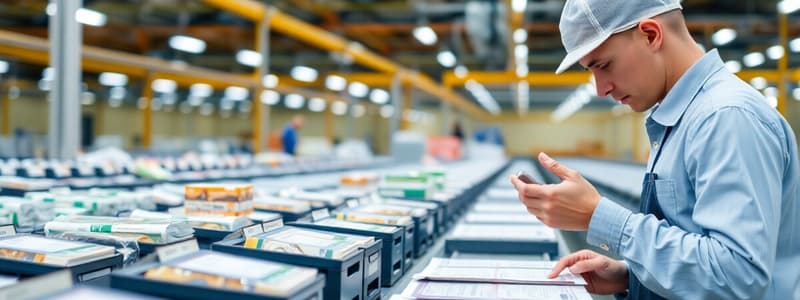Podcast
Questions and Answers
In the context of economic production, which factor refers to the knowledge and skills acquired by workers through education and experience?
In the context of economic production, which factor refers to the knowledge and skills acquired by workers through education and experience?
- Human capital (correct)
- Technological knowledge
- Physical capital
- Natural resources
Which of the following best describes the concept of 'Diminishing Marginal Returns' in the context of a production function?
Which of the following best describes the concept of 'Diminishing Marginal Returns' in the context of a production function?
- The cost of each additional unit of input decreases as production increases.
- Additional units of one input, holding other factors constant, yield progressively smaller increases in output. (correct)
- Each additional unit of input yields a constant increase in output.
- The total output decreases as more input is added.
What is the primary impact of investment in physical capital on production?
What is the primary impact of investment in physical capital on production?
- It increases the stock of physical capital and generally boosts output. (correct)
- It has no impact on overall output.
- It decreases the stock of physical capital.
- It only affects production in the short term, with no long-term impact.
According to the principles of capital accumulation, what is the impact of diminishing returns?
According to the principles of capital accumulation, what is the impact of diminishing returns?
How does technological progress affect the production function?
How does technological progress affect the production function?
What does Total Factor Productivity (TFP) primarily capture?
What does Total Factor Productivity (TFP) primarily capture?
According to the Solow Growth Model, what factors primarily explain long-run economic growth?
According to the Solow Growth Model, what factors primarily explain long-run economic growth?
In the context of the Solow Growth Model, what is a 'steady state'?
In the context of the Solow Growth Model, what is a 'steady state'?
What is the 'catch-up effect'?
What is the 'catch-up effect'?
Which of the following factors has been shown to influence economic growth rates across countries?
Which of the following factors has been shown to influence economic growth rates across countries?
Which policy would directly encourage investment in physical capital?
Which policy would directly encourage investment in physical capital?
Why is technological progress crucial for sustained long-run economic growth?
Why is technological progress crucial for sustained long-run economic growth?
What role do strong institutions play in promoting economic growth?
What role do strong institutions play in promoting economic growth?
According to the production function, which of the following is NOT a direct input?
According to the production function, which of the following is NOT a direct input?
Which factor is least likely to influence a country's movement toward its steady state, according to the Solow model?
Which factor is least likely to influence a country's movement toward its steady state, according to the Solow model?
Holding all other factors constant, what is the most likely outcome of a country significantly increasing its investment in education and training?
Holding all other factors constant, what is the most likely outcome of a country significantly increasing its investment in education and training?
Which of the following scenarios would most likely result in sustained economic growth, according to the Solow model?
Which of the following scenarios would most likely result in sustained economic growth, according to the Solow model?
What is the primary reason why cross-country data shows wide variations in growth rates?
What is the primary reason why cross-country data shows wide variations in growth rates?
Why might increased government spending NOT be considered the most crucial factor for achieving sustained long-run economic growth?
Why might increased government spending NOT be considered the most crucial factor for achieving sustained long-run economic growth?
What is a key challenge economies face in sustaining high levels of investment over time?
What is a key challenge economies face in sustaining high levels of investment over time?
Flashcards
Production Function
Production Function
The function that describes relationship between inputs and outputs.
Physical Capital
Physical Capital
The stock of equipment and structures used to produce goods and services.
Human Capital
Human Capital
The knowledge and skills that workers acquire through education, training, and experience.
Natural Resources
Natural Resources
Signup and view all the flashcards
Technological Knowledge
Technological Knowledge
Signup and view all the flashcards
Diminishing Marginal Returns
Diminishing Marginal Returns
Signup and view all the flashcards
Investment
Investment
Signup and view all the flashcards
Steady State
Steady State
Signup and view all the flashcards
Technological Progress
Technological Progress
Signup and view all the flashcards
Total Factor Productivity
Total Factor Productivity
Signup and view all the flashcards
Solow Growth Model
Solow Growth Model
Signup and view all the flashcards
Transitional Dynamics
Transitional Dynamics
Signup and view all the flashcards
Catch-up Effect
Catch-up Effect
Signup and view all the flashcards
Encouraging Investment
Encouraging Investment
Signup and view all the flashcards
Human Capital
Human Capital
Signup and view all the flashcards
Innovation
Innovation
Signup and view all the flashcards
Institutional Reforms
Institutional Reforms
Signup and view all the flashcards
Study Notes
Production and Growth Overview
- Productivity determinants include physical capital, human capital, natural resources, and technological knowledge.
- The production function links inputs to output
Production Function
- Denotes "Y" as the quantity of output, "L" as the quantity of labor, "K" as the quantity of physical capital, "H" as the quantity of human capital, and "N" as the quantity of natural resources.
- Describes the relationship between inputs (labor L, physical capital K, human capital H, natural resources H, and technology A) and output Y.
- The common formulation is that Y = A · F(L, K, H, N)
- Diminishing Marginal Returns occurs when additional units of one input yield progressively smaller increases in output, holding other factors constant.
Capital Accumulation
- Investment increases the stock of physical capital.
- A higher capital stock generally boosts output
- Additional capital eventually contributes less to output growth.
- Dynamics of capital accumulation are movement toward the steady state where net investment equals depreciation.
Role of Technology
- Technological progress increases productivity and shifts the production function upward.
- Total Factor Productivity (TFP) captures the efficiency with which inputs are used.
- Technology can drive long-run growth, even if capital accumulation faces diminishing returns.
Solow Growth Model
- Explains long-run growth via capital accumulation, labor force growth, and technological progress.
- Introduces the concept of a steady state where capital per worker remains constant.
- Poorer economies may grow faster than richer ones if they have similar savings rates, population growth, and access to technology, called convergence.
Steady State and Transitional Dynamics
- Steady State is the point at which net investment equals depreciation.
- Transitional Dynamics refers to the process by which an economy converges to its steady state.
- Savings rates, population growth, and technology investments affect the speed of convergence, which has policy implications.
- Catch-up effect refers to countries that start off poor tend to grow more rapidly than countries that start off rich.
Empirical Evidence on Growth
- Cross-country data show wide variations in growth rates.
- Factors influencing growth include institutional quality, human capital accumulation, and innovation and technology adoption.
Policy Implications
- Encouraging investment can be done through policies that promote savings and investment in physical capital.
- Human capital can be improved by investing in education and training to improve labor productivity.
- Innovation can be driven by Supporting research and development to.
- Institutional reforms involve Creating an environment that fosters efficient markets and robust institutions.
Key Takeaways
- The production function links inputs (capital, labor, technology) to output.
- Capital accumulation boosts production but faces diminishing returns.
- Technological progress is the key driver of sustained long-run growth.
- The Solow model provides a useful framework for understanding growth dynamics and convergence.
Factors for Achieving Sustained Long-Run Growth
- Only technological progress can shift the production function upward permanently, even though capital and labor contribute to growth.
Further Considerations
- Consider how institutions and policies affect technology adoption.
- Consider What are the challenges in sustaining high levels of investment.
- Consider how economies can overcome the limitations imposed by diminishing returns.
Studying That Suits You
Use AI to generate personalized quizzes and flashcards to suit your learning preferences.




